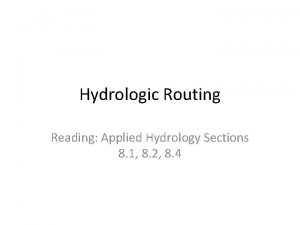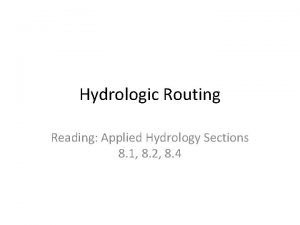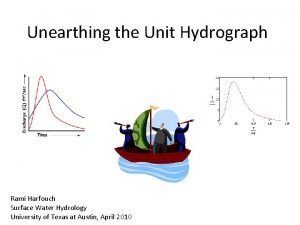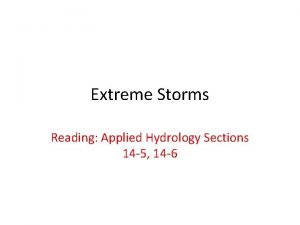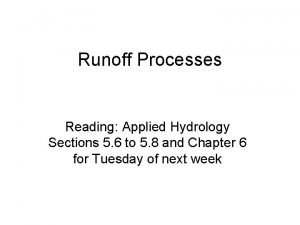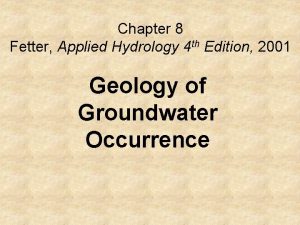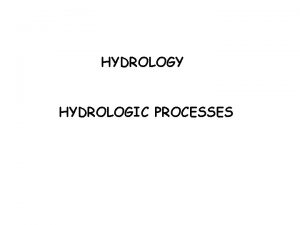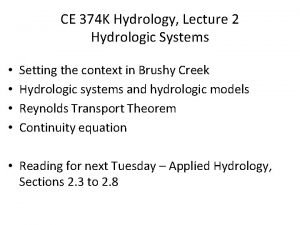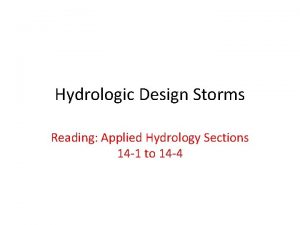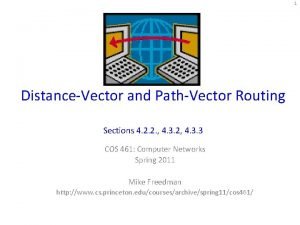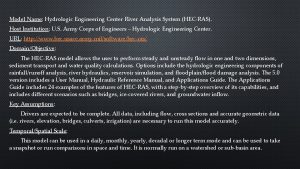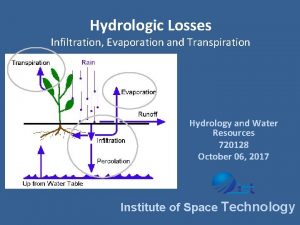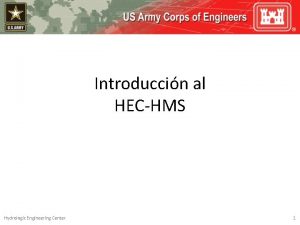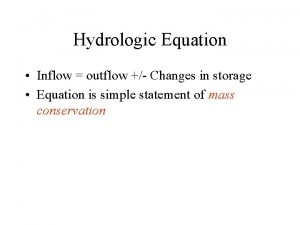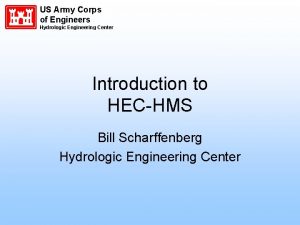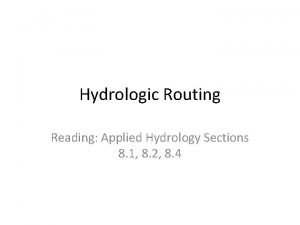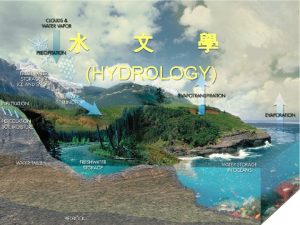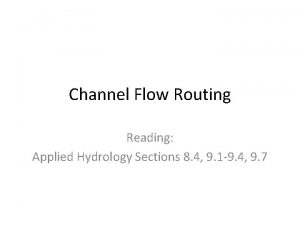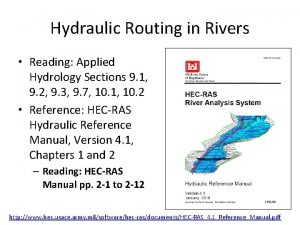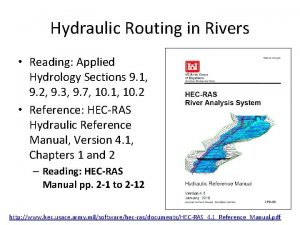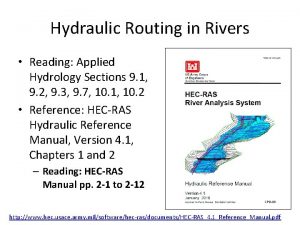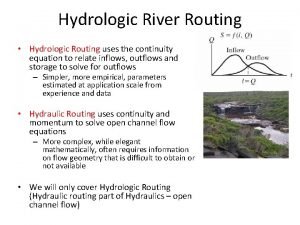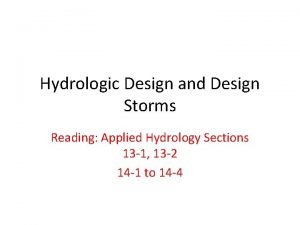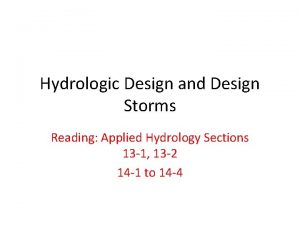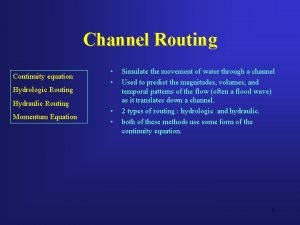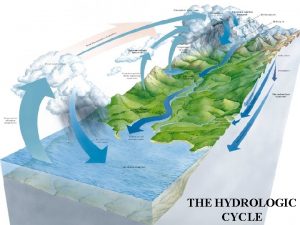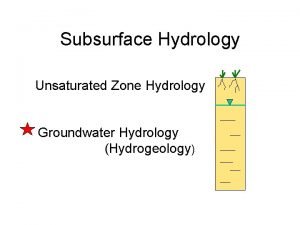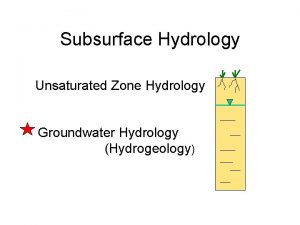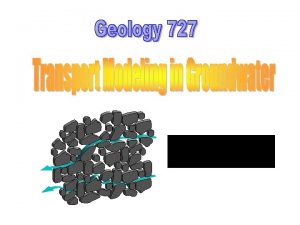Hydrologic Routing Reading Applied Hydrology Sections 8 1





















- Slides: 21

Hydrologic Routing Reading: Applied Hydrology Sections 8. 1, 8. 2, 8. 4

Flow Routing Q t • Procedure to determine the flow hydrograph at a point on a watershed from a known hydrograph upstream • As the hydrograph travels, it – attenuates – gets delayed Q t Q t 2

Why route flows? Q t n n Account for changes in flow hydrograph as a flood wave passes downstream This helps in n n Accounting for storages Studying the attenuation of flood peaks 3

Types of flow routing • Lumped/hydrologic – Flow is calculated as a function of time alone at a particular location – Governed by continuity equation and flow/storage relationship • Distributed/hydraulic – Flow is calculated as a function of space and time throughout the system – Governed by continuity and momentum equations 4

Hydrologic Routing Discharge Inflow Transfer Function Downstream hydrograph Upstream hydrograph Input, output, and storage are related by continuity equation: Q and S are unknown Storage can be expressed as a function of I(t) or Q(t) or both For a linear reservoir, S=k. Q Outflow 5

Lumped flow routing • Three types 1. Level pool method (Modified Puls) – Storage is nonlinear function of Q 2. Muskingum method – Storage is linear function of I and Q 3. Series of reservoir models – Storage is linear function of Q and its time derivatives 6

S and Q relationships 7

Level pool routing • Procedure for calculating outflow hydrograph Q(t) from a reservoir with horizontal water surface, given its inflow hydrograph I(t) and storage-outflow relationship 8

Level pool methodology Discharge Inflow Outflow Time Storage Unknown Need a function relating 9 Time Storage-outflow function Known

Level pool methodology • Given – Inflow hydrograph – Q and H relationship • Steps 1. Develop Q versus Q+ 2 S/Dt relationship using Q/H relationship 2. Compute Q+ 2 S/Dt using 3. Use the relationship developed in step 1 to get Q 10

Ex. 8. 2. 1 Given I(t) Given Q/H Area of the reservoir = 1 acre, and outlet diameter = 5 ft 11

Ex. 8. 2. 1 Step 1 Develop Q versus Q+ 2 S/Dt relationship using Q/H relationship 12

Step 2 Compute Q+ 2 S/Dt using At time interval =1 (j=1), I 1 = 0, and therefore Q 1 = 0 as the reservoir is empty Write the continuity equation for the first time step, which can be used to compute Q 2 13

Step 3 Use the relationship between 2 S/Dt + Q versus Q to compute Q Use the Table/graph created in Step 1 to compute Q What is the value of Q if 2 S/Dt + Q = 60 ? So Q 2 is 2. 4 cfs Repeat steps 2 and 3 for j=2, 3, 4… to compute Q 3, Q 4, Q 5…. . 14

Ex. 8. 2. 1 results 15

Ex. 8. 2. 1 results Outflow hydrograph Inflow Peak outflow intersects with the receding limb of the inflow hydrograph Outflow 16

Q/H relationships http: //www. wsi. nrcs. usda. gov/products/W 2 Q/H&H/Tools_Models/Sites. html 17 an NRCS Reservoir Program for Routing Flow through

Hydrologic river routing (Muskingum Method) Wedge storage in reach Advancing Flood Wave I>Q K = travel time of peak through the reach X = weight on inflow versus outflow (0 ≤ X ≤ 0. 5) X = 0 Reservoir, storage depends on outflow, no wedge X = 0. 0 - 0. 3 Natural stream Receding Flood Wave Q>I

Muskingum Method (Cont. ) Recall: Combine: If I(t), K and X are known, Q(t) can be calculated using above 19 equations

Muskingum - Example • Given: – Inflow hydrograph – K = 2. 3 hr, X = 0. 15, Dt = 1 hour, Initial Q = 85 cfs • Find: – Outflow hydrograph using Muskingum routing method 20

Muskingum – Example (Cont. ) C 1 = 0. 0631, C 2 = 0. 3442, C 3 = 0. 5927 21
 Hydrologic routing and hydraulic routing
Hydrologic routing and hydraulic routing Level pool routing
Level pool routing Hydrologic routing
Hydrologic routing Applied hydrology
Applied hydrology Applied hydrology
Applied hydrology Applied hydrology
Applied hydrology Applied hydrology
Applied hydrology Applied hydrology
Applied hydrology Applied hydrology
Applied hydrology Reynolds transport theorem
Reynolds transport theorem Hyteograph
Hyteograph Distance vector routing algorithm
Distance vector routing algorithm Static routing and dynamic routing
Static routing and dynamic routing Clock routing
Clock routing Pre reading while reading and post reading activities
Pre reading while reading and post reading activities River analysis system
River analysis system Infiltration
Infiltration Hydrology continuity equation
Hydrology continuity equation Hydrologic engineering center
Hydrologic engineering center Write the inflow as a formula
Write the inflow as a formula Hydrologic engineering center
Hydrologic engineering center Hydrologic abstractions
Hydrologic abstractions


